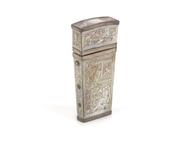





Pewter enema syringe piston-action, with vaginal nozzle, 18th or 19th century
Treating patients via an enema dates back to ancient Egypt. It was a common treatment during the 1800s when stimulants such as tobacco and coffee were used alongside other substances. This piston-action enema syringe is made of pewter and was a multi-purpose tool. It has a vaginal nozzle attached and originally may have had a rectal one too. Enemas are now administered before certain surgery to wash out the lower bowel as a hygiene measure, or to introduce medications, salts or minerals into the body. In the past they were prescribed for complaints and ailments as minor as indigestion or headaches.
Details
- Category:
- Therapeutics
- Collection:
- Sir Henry Wellcome's Museum Collection
- Object Number:
- A87957
- Materials:
- whole, pewter and wood
- Measurements:
-
overall: 352 mm x 130 mm 44 mm, .34 kg
- type:
- enema syringe
- credit:
- Ugo, B.




